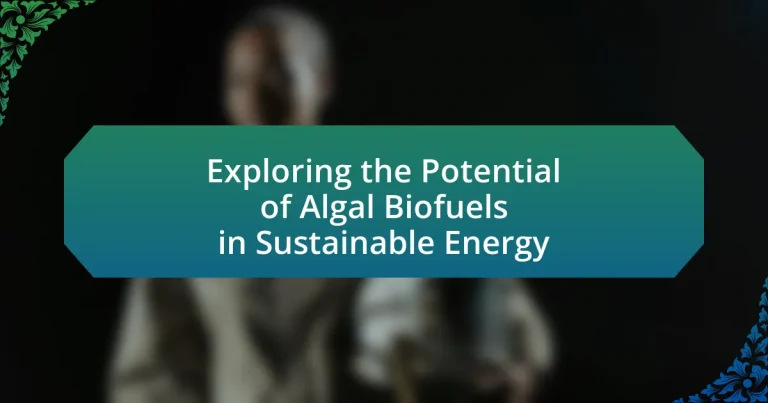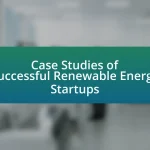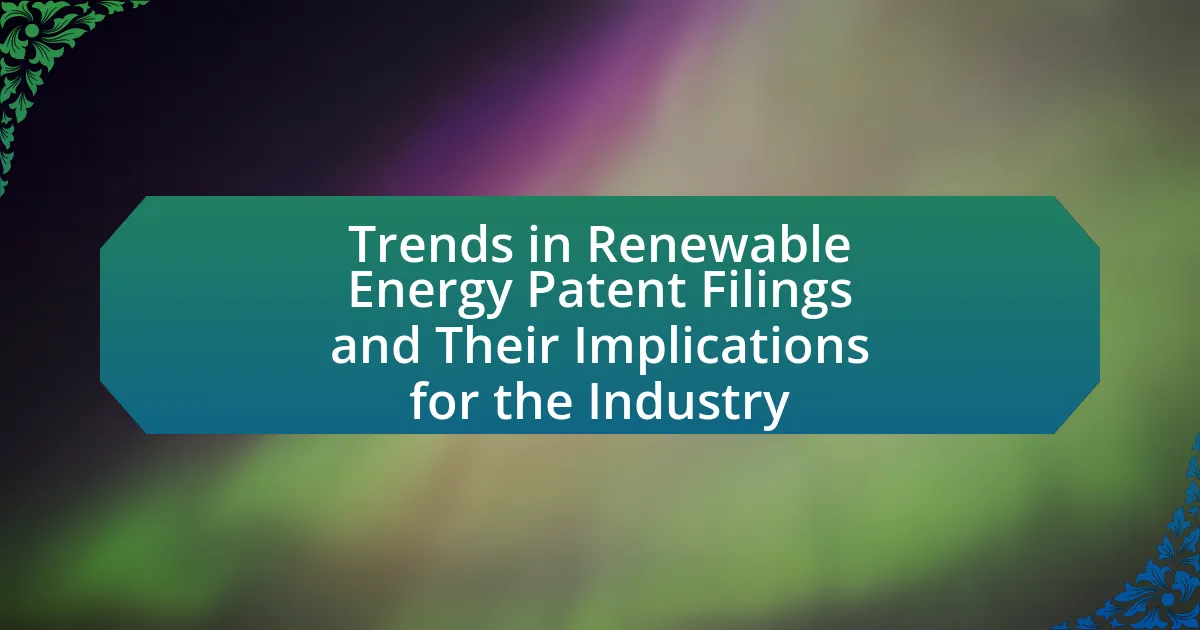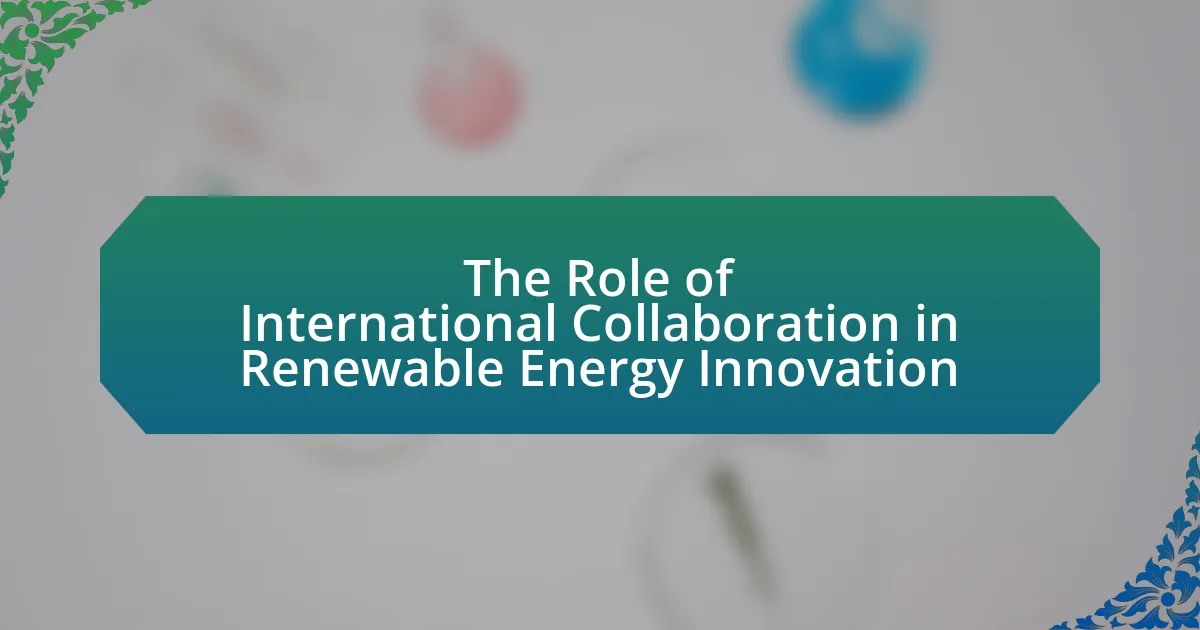Algal biofuels, derived from algae, represent a promising renewable energy source that can be converted into biodiesel, bioethanol, and other fuels. This article explores their role in sustainable energy, highlighting their potential to reduce greenhouse gas emissions, utilize non-arable land, and yield significantly higher oil production compared to traditional crops. It details the production processes, types of algae used, environmental benefits, and challenges faced in the industry, including high production costs and technological limitations. Additionally, the article discusses future prospects, policy support, and practical steps to promote algal biofuels as a viable alternative to fossil fuels.
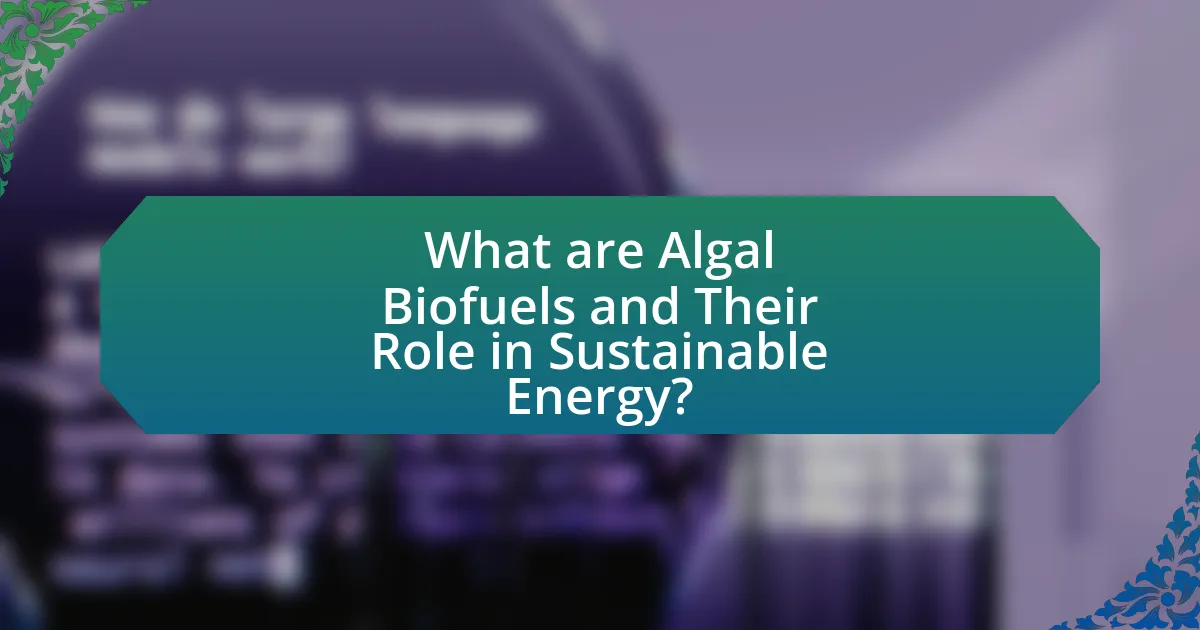
What are Algal Biofuels and Their Role in Sustainable Energy?
Algal biofuels are renewable energy sources derived from algae, which can be converted into biodiesel, bioethanol, and other fuels. These biofuels play a significant role in sustainable energy by providing an alternative to fossil fuels, reducing greenhouse gas emissions, and utilizing non-arable land for cultivation. Research indicates that algae can produce up to 30 times more oil per acre than traditional crops, making them a highly efficient feedstock for biofuel production. Additionally, algae can absorb carbon dioxide during growth, further contributing to their sustainability credentials.
How are algal biofuels produced?
Algal biofuels are produced through the cultivation of algae, which are then processed to extract oils that can be converted into biodiesel or other fuels. The production process typically involves several steps: first, algae are grown in controlled environments, such as photobioreactors or open ponds, where they utilize sunlight and nutrients to grow rapidly. Once harvested, the algae undergo lipid extraction, where oils are separated from the biomass using methods like mechanical pressing or solvent extraction. Finally, these oils are converted into biofuels through processes such as transesterification, which transforms the oils into fatty acid methyl esters (biodiesel). This method is supported by research indicating that algal biofuels can yield significantly higher energy per acre compared to traditional crops, making them a promising alternative for sustainable energy.
What types of algae are used for biofuel production?
The types of algae used for biofuel production primarily include microalgae and macroalgae. Microalgae, such as Chlorella, Spirulina, and Scenedesmus, are favored for their high lipid content, which can be converted into biodiesel. Macroalgae, including species like kelp and seaweed, are also explored for bioethanol and biogas production due to their rapid growth rates and ability to absorb carbon dioxide. Research indicates that microalgae can produce up to 30 times more oil per acre than traditional crops, making them a promising source for sustainable biofuels.
What processes are involved in converting algae to biofuels?
The processes involved in converting algae to biofuels include cultivation, harvesting, lipid extraction, and transesterification. Cultivation involves growing algae in controlled environments, such as photobioreactors or open ponds, where they can efficiently absorb sunlight and nutrients. Harvesting follows, where the biomass is collected, typically using methods like centrifugation or filtration. Lipid extraction is the next step, where oils are separated from the algal biomass, often using solvents or mechanical processes. Finally, transesterification converts the extracted lipids into biodiesel through a chemical reaction with alcohol, usually methanol, in the presence of a catalyst. This multi-step process is supported by research indicating that algae can produce up to 30 times more oil per acre than traditional crops, making them a promising source for sustainable biofuels.
Why are algal biofuels considered sustainable?
Algal biofuels are considered sustainable because they can be produced using non-arable land and do not compete with food crops for resources. Algae can grow in a variety of environments, including saltwater and wastewater, which allows for the utilization of resources that would otherwise be wasted. Additionally, algal biofuels have a high yield per acre compared to traditional biofuels, with some species capable of producing up to 30 times more oil than conventional crops. This efficiency, combined with the ability of algae to absorb carbon dioxide during growth, contributes to a lower overall carbon footprint, making algal biofuels a more environmentally friendly alternative to fossil fuels.
What environmental benefits do algal biofuels provide?
Algal biofuels provide significant environmental benefits, including reduced greenhouse gas emissions and improved carbon capture. Specifically, algal biofuels can lower carbon dioxide emissions by up to 70% compared to fossil fuels, as algae absorb CO2 during their growth process. Additionally, algal biofuels can be produced using non-arable land and wastewater, which minimizes competition with food crops and reduces nutrient pollution in water bodies. This sustainable approach not only conserves land resources but also enhances water quality by utilizing nutrients that would otherwise contribute to harmful algal blooms.
How do algal biofuels compare to traditional fossil fuels?
Algal biofuels are generally considered more sustainable and environmentally friendly compared to traditional fossil fuels. Unlike fossil fuels, which release significant amounts of carbon dioxide and other greenhouse gases when burned, algal biofuels can be produced with a lower carbon footprint. For instance, studies indicate that algal biofuels can reduce greenhouse gas emissions by up to 80% compared to fossil fuels. Additionally, algal biofuels can be cultivated on non-arable land and utilize wastewater, minimizing competition with food crops and reducing water usage. This contrasts with fossil fuel extraction, which often leads to habitat destruction and pollution. Therefore, algal biofuels present a promising alternative that aligns with sustainable energy goals.

What are the Challenges Facing Algal Biofuels?
The challenges facing algal biofuels include high production costs, technological limitations, and scalability issues. High production costs arise from the need for specialized cultivation systems, nutrient inputs, and harvesting processes, which can exceed the costs of conventional fossil fuels. Technological limitations involve the efficiency of converting algal biomass into usable fuel, as current methods may not yield sufficient energy output. Scalability issues pertain to the difficulty in producing algal biofuels at a scale that meets commercial demand, as large-scale cultivation can be hindered by environmental factors and resource availability. These challenges hinder the widespread adoption of algal biofuels as a viable alternative energy source.
What are the economic barriers to algal biofuel production?
The economic barriers to algal biofuel production include high production costs, limited scalability, and competition with established fossil fuels. High production costs arise from the need for advanced technologies and infrastructure for cultivation, harvesting, and processing of algae, which can exceed $10 per gallon, making it economically unviable compared to traditional fuels. Limited scalability is a challenge because current production methods are not yet capable of meeting large-scale energy demands, hindering investment and development. Additionally, established fossil fuels benefit from existing infrastructure and lower prices, making it difficult for algal biofuels to compete in the market. These factors collectively impede the growth and adoption of algal biofuels as a sustainable energy source.
How do production costs affect the viability of algal biofuels?
Production costs significantly impact the viability of algal biofuels by determining their competitiveness against conventional fuels. High production costs, primarily due to cultivation, harvesting, and processing, can render algal biofuels economically unfeasible. For instance, studies indicate that the cost of producing algal biofuels can exceed $10 per gallon, while fossil fuels often remain below $3 per gallon. This price disparity limits market adoption and investment in algal biofuel technologies. Additionally, advancements in production efficiency and cost reduction strategies, such as optimizing growth conditions and utilizing waste streams, are essential for enhancing the economic viability of algal biofuels.
What funding opportunities exist for algal biofuel research?
Funding opportunities for algal biofuel research include government grants, private sector investments, and academic partnerships. The U.S. Department of Energy (DOE) offers funding through initiatives like the Bioenergy Technologies Office, which has allocated millions for algal biofuel projects. Additionally, the National Science Foundation (NSF) provides grants for innovative research in renewable energy, including algal biofuels. Private companies and venture capitalists are increasingly investing in startups focused on algal biofuel technologies, recognizing the potential for sustainable energy solutions. Furthermore, collaborations with universities often lead to access to research funding and resources aimed at advancing algal biofuel development.
What technological challenges hinder algal biofuel development?
Technological challenges that hinder algal biofuel development include high production costs, inefficient harvesting methods, and limited scalability of cultivation systems. High production costs arise from the need for specialized equipment and conditions to grow algae effectively, which can exceed the costs of traditional biofuels. Inefficient harvesting methods, such as centrifugation and filtration, often lead to significant energy consumption and yield losses, making it difficult to extract biofuels economically. Additionally, the limited scalability of cultivation systems, particularly in open ponds or photobioreactors, restricts the ability to produce algal biofuels at a commercially viable scale. These challenges collectively impede the advancement and adoption of algal biofuels in the renewable energy market.
What advancements are needed in algal cultivation techniques?
Advancements needed in algal cultivation techniques include improved strain selection, optimized growth conditions, and enhanced harvesting methods. Research indicates that selecting high-yield algal strains can significantly increase biomass production, with studies showing that certain strains can produce up to 30 times more oil than conventional crops. Additionally, optimizing growth conditions such as light, temperature, and nutrient availability can enhance photosynthetic efficiency, leading to faster growth rates. Furthermore, developing more efficient harvesting techniques, such as flocculation or centrifugation, can reduce costs and energy consumption, making algal biofuels more economically viable.
How can processing technologies be improved for better efficiency?
Processing technologies can be improved for better efficiency by optimizing extraction methods and enhancing conversion processes. For instance, utilizing advanced techniques such as supercritical fluid extraction can significantly increase the yield of bioactive compounds from algal biomass. Research indicates that supercritical CO2 extraction can achieve extraction efficiencies of over 90%, compared to traditional methods that often yield less than 50%. Additionally, integrating biorefinery approaches that utilize multiple outputs from algal processing can enhance overall resource utilization and reduce waste, thereby improving economic viability and sustainability in algal biofuel production.
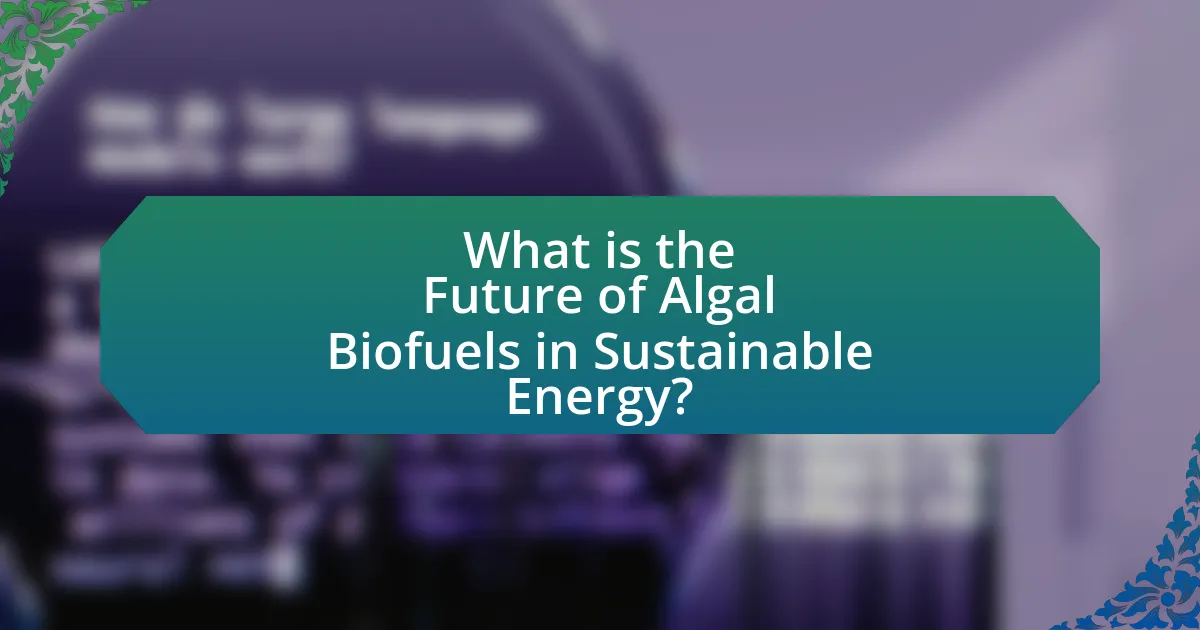
What is the Future of Algal Biofuels in Sustainable Energy?
The future of algal biofuels in sustainable energy is promising, driven by advancements in technology and increasing demand for renewable energy sources. Algal biofuels can produce significantly higher yields per acre compared to traditional crops, with some studies indicating potential oil yields of up to 5,000 gallons per acre annually. Furthermore, algae can utilize carbon dioxide from industrial emissions, contributing to greenhouse gas reduction. Research from the National Renewable Energy Laboratory highlights that algal biofuels can play a crucial role in achieving energy independence and reducing reliance on fossil fuels. As investment in algal biofuel technology continues to grow, its integration into the energy market is expected to expand, making it a viable alternative in the transition to sustainable energy systems.
How can policy support the growth of algal biofuels?
Policy can support the growth of algal biofuels by providing financial incentives, regulatory frameworks, and research funding. Financial incentives, such as tax credits and subsidies, can lower production costs and encourage investment in algal biofuel technologies. Regulatory frameworks can streamline the approval process for algal biofuel projects, making it easier for companies to enter the market. Additionally, government funding for research and development can accelerate innovation in algal biofuel production methods, enhancing efficiency and reducing costs. For instance, the U.S. Department of Energy has invested millions in algal biofuel research, demonstrating the impact of policy on advancing this sector.
What regulations are currently in place for biofuel production?
Current regulations for biofuel production include the Renewable Fuel Standard (RFS) in the United States, which mandates the blending of renewable fuels into the transportation fuel supply. The RFS sets specific volume requirements for different types of biofuels, including advanced biofuels and cellulosic biofuels, to promote the use of renewable energy sources and reduce greenhouse gas emissions. Additionally, the European Union has implemented the Renewable Energy Directive (RED II), which establishes sustainability criteria for biofuels, ensuring that they contribute to greenhouse gas savings and do not compete with food production. These regulations are designed to support the growth of the biofuel industry while addressing environmental and social concerns.
How can governments incentivize algal biofuel research and development?
Governments can incentivize algal biofuel research and development by providing financial support through grants, tax credits, and subsidies specifically aimed at research institutions and private companies. For instance, the U.S. Department of Energy has allocated funding for algal biofuel projects, demonstrating a commitment to advancing this technology. Additionally, establishing regulatory frameworks that promote the use of algal biofuels can create a stable market environment, encouraging investment. Countries like Brazil have implemented policies that support biofuel production, showcasing the effectiveness of government intervention in fostering innovation in this sector.
What innovations are on the horizon for algal biofuels?
Innovations on the horizon for algal biofuels include advancements in genetic engineering, which enhance lipid production in algae, and improvements in cultivation techniques, such as photobioreactors that optimize light exposure. Genetic modifications can increase oil yield by up to 50%, as demonstrated in studies by the National Renewable Energy Laboratory. Additionally, integrated systems that combine wastewater treatment with algal cultivation are being developed, which can reduce costs and improve sustainability. These innovations are crucial for making algal biofuels a viable alternative to fossil fuels.
What role does biotechnology play in enhancing algal biofuel production?
Biotechnology significantly enhances algal biofuel production by optimizing algal strains for higher lipid yields and improving cultivation processes. Genetic engineering techniques, such as CRISPR and synthetic biology, enable the modification of algal genomes to increase oil content and growth rates, leading to more efficient biofuel production. For instance, research has shown that genetically modified strains of microalgae can produce up to 50% more lipids compared to their wild-type counterparts. Additionally, biotechnological advancements in metabolic engineering allow for the manipulation of metabolic pathways, further increasing the efficiency of lipid accumulation in algal cells. These innovations demonstrate the critical role of biotechnology in making algal biofuels a viable and sustainable energy source.
How can partnerships between industry and academia drive progress?
Partnerships between industry and academia can drive progress by facilitating the exchange of knowledge and resources, leading to innovative solutions in algal biofuels. These collaborations enable academic researchers to access real-world data and funding from industry, while companies benefit from cutting-edge research and technological advancements. For instance, the collaboration between the University of California, San Diego, and Sapphire Energy resulted in significant advancements in algal biofuel production, demonstrating how joint efforts can accelerate the development of sustainable energy solutions. Such partnerships not only enhance research capabilities but also promote the commercialization of new technologies, ultimately contributing to the growth of the algal biofuels sector.
What practical steps can be taken to promote algal biofuels?
To promote algal biofuels, stakeholders should invest in research and development to enhance algal strains for higher oil yields. This investment can lead to breakthroughs in genetic engineering and cultivation techniques, which are essential for improving productivity. For instance, studies have shown that specific strains of microalgae can produce up to 50% of their dry weight in oil, significantly increasing the feasibility of algal biofuels as a sustainable energy source.
Additionally, establishing partnerships between academia, industry, and government can facilitate knowledge sharing and resource allocation, driving innovation in algal biofuel technologies. Implementing supportive policies and incentives, such as tax breaks or grants for algal biofuel projects, can further stimulate investment and development in this sector.
Moreover, increasing public awareness and education about the benefits of algal biofuels can create a more favorable market environment. Research indicates that consumer acceptance is crucial for the adoption of alternative fuels, and educational campaigns can help inform the public about the environmental advantages of algal biofuels compared to fossil fuels.
Finally, developing infrastructure for large-scale production and distribution of algal biofuels is vital. This includes creating facilities for cultivation, harvesting, and processing, which can help reduce costs and improve accessibility. By taking these practical steps, the promotion of algal biofuels can be effectively advanced, contributing to sustainable energy solutions.
What best practices should be followed in algal biofuel projects?
Best practices in algal biofuel projects include selecting high-yield algal strains, optimizing growth conditions, and implementing efficient harvesting techniques. High-yield strains, such as Chlorella and Spirulina, can significantly enhance biomass production, with some strains capable of producing up to 50% of their dry weight in lipids. Optimizing growth conditions, including light, temperature, and nutrient availability, is crucial for maximizing algal growth rates; for instance, controlled environments can increase productivity by 30-50%. Efficient harvesting techniques, such as flocculation or centrifugation, are essential to minimize costs and energy use, as harvesting can account for up to 20% of total production costs. These practices collectively contribute to the economic viability and sustainability of algal biofuel production.
How can individuals contribute to the adoption of algal biofuels?
Individuals can contribute to the adoption of algal biofuels by supporting research initiatives and advocating for policies that promote sustainable energy sources. By participating in community programs that focus on renewable energy education, individuals can raise awareness about the benefits of algal biofuels, which are known to produce significantly lower greenhouse gas emissions compared to fossil fuels. Furthermore, individuals can invest in or purchase products from companies that specialize in algal biofuel production, thereby driving demand and encouraging further development in this sector. Engaging in discussions on social media platforms about the advantages of algal biofuels can also help spread knowledge and influence public opinion, ultimately fostering a more favorable environment for the adoption of this sustainable energy source.
